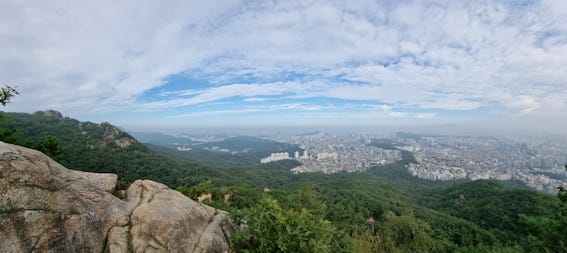Discover the Mystical Beauty of Gwanaksan Mountain in South Korea
Nestled in the scenic landscapes of South Korea, Gwanaksan Mountain stands as a majestic and revered natural gem. With its breathtaking peaks, serene valleys, and rich cultural heritage, Gwanaksan offers an unforgettable experience for hikers, nature enthusiasts, and history buffs alike.
A Natural Wonder:
Gwanaksan Mountain is widely regarded as one of the five representative mountains in Gyeonggi-do, alongside other notable peaks in the region. Its diverse topography, adorned with awe-inspiring rock formations, ancient trees, and vibrant plant life, paints a picturesque scene that changes with each passing season. Often referred to as Sogeumgang or Seogeumgang, meaning "Small Geumgang" or "West Geumgang," Gwanaksan showcases striking similarities to the renowned Geumgangsan Mountain.
Ecology of Gwanaksan Mountain:
Gwanaksan Mountain boasts a unique ecology shaped by its rocky terrain. The barren peaks are home to resilient flora such as pine trees and azaleas, while the crevices between rocks nurture the growth of rare species like the long-leaf Korean boxwood. The mountain hosts a total of 11 species of Korean-indigenous plants, including four rare plants that add to its biodiversity. While large wild animals are not commonly seen, small creatures like Korean hares, squirrels, weasels, and moles find their habitat here. Additionally, birdwatchers can delight in observing the 41 species of birds that grace the mountain with their presence.
Attractions of Gwanaksan Mountain:
Gwanaksan Mountain offers a plethora of attractions that enchant visitors and provide glimpses into its storied past. Among the peaks, Yeonjudae Hermitage Monument No. 20 stands as a rugged cliff resembling bamboo shoots. This historic hermitage was originally built by Buddhist Monk Uisang in the 7th century and was later renamed "Yeonjudae," reflecting the longing of Goryeo Dynasty retainers for their former glory.
Yeonjudae Hermitage Monument No. 20:
Located amidst the peaks of Gwanaksan Mountain, Yeonjudae Hermitage stands as a rugged cliff resembling the shape of bamboo shoots. Originally known as "Uisangdae," this mountain hermitage was built in the 17th year of King Munmu's reign (677) by Buddhist Monk Uisang. Over time, it was renamed "Yeonjudae," reflecting the sentiments of Goryeo Dynasty retainers who missed their old prosperity following the dynasty's collapse. Visit this historical site at San 12-4, Jungang-dong, Gwancheon, Gyeonggi-do.
Yeonjuam Hermitage:
Situated on the south side of Yeonjubong Peak, Yeonjuam Hermitage is a well-known temple among frequent visitors to Gwanaksan Mountain. Its roots trace back to Gwanaksa Temple, established by Buddhist Monk Uisang in 677. The temple later moved to its present location and was renamed Yeonjuam. Marvel at the three-story stone pagoda in front of the Daeungjeon Hall, an architectural gem that reveals the temple's ancient origins.
Gukgibong Peak:
Gukgibong Peak, a part of Samseongsan Mountain, forms a picturesque valley adjacent to Seoul National University. With its rocky ridge and dense pine tree forest, this peak offers a remarkable vantage point to behold the grandeur of Gwanaksan Mountain, the main ridge of Samseongsan Mountain, and the Janggunbong Peak ridge. Experience the awe-inspiring beauty of Gukgibong, making it one of the most notable courses in Gwanaksan Valley.
Yeollyeoam Rock:
Embark on the uphill journey along the Seoul National University Trail from Gwanaksan Mountain's Plaza 2, and you'll encounter the enchanting Yeollyeoam Rock on the right side. This rock holds a legendary tale of a devoted lady who, despite tragedy and temptation, remained steadfast in her love for her family. Her unwavering prayers atop this sacred rock were witnessed by a toad and a dog, who were moved by her devotion and offered their protection. Legend has it that the lady eventually transformed into a fossil, leaving a lasting testament to her unwavering spirit.
Hiking Trails
There are a number of hiking trails that lead to the summit of Gwanaksan Mountain. The most popular trail is the Seoul National University Trail, which is about 4 kilometers long. The trail is relatively easy and offers stunning views of the city.
How to Get There
Getting to Gwanaksan Mountain is relatively easy, thanks to its convenient location near Seoul, South Korea. Here are a few transportation options to reach the mountain:
By Public Transportation:
Subway: Take Line 2 (Green Line) of the Seoul Metropolitan Subway and get off at Seoul National University Station (Exit 3). From there, you can walk to the entrance of Gwanaksan Mountain, which is approximately a 10-minute walk.
Bus: Several buses serve the Gwanaksan Mountain area. You can take buses such as 5511, 5513, 5517, 5528, 6512, or 6513, among others, and get off at the entrance of Gwanaksan Mountain.
By Car:
If you prefer to drive, you can use a GPS navigation system to guide you to Gwanaksan Mountain. The mountain is easily accessible via major roads and highways, and parking facilities are available near the entrance.









